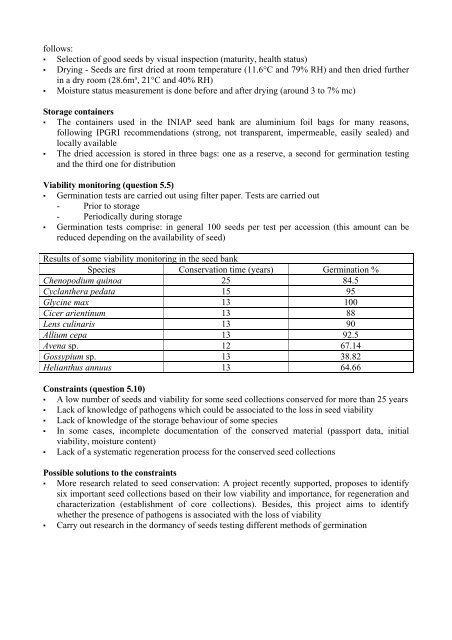Improving the identification, handling and storage of âdifficultâ seeds ...
Improving the identification, handling and storage of âdifficultâ seeds ...
Improving the identification, handling and storage of âdifficultâ seeds ...
Create successful ePaper yourself
Turn your PDF publications into a flip-book with our unique Google optimized e-Paper software.
follows:<br />
▪ Selection <strong>of</strong> good <strong>seeds</strong> by visual inspection (maturity, health status)<br />
▪ Drying - Seeds are first dried at room temperature (11.6°C <strong>and</strong> 79% RH) <strong>and</strong> <strong>the</strong>n dried fur<strong>the</strong>r<br />
in a dry room (28.6m³, 21°C <strong>and</strong> 40% RH)<br />
▪ Moisture status measurement is done before <strong>and</strong> after drying (around 3 to 7% mc)<br />
Storage containers<br />
▪ The containers used in <strong>the</strong> INIAP seed bank are aluminium foil bags for many reasons,<br />
following IPGRI recommendations (strong, not transparent, impermeable, easily sealed) <strong>and</strong><br />
locally available<br />
▪ The dried accession is stored in three bags: one as a reserve, a second for germination testing<br />
<strong>and</strong> <strong>the</strong> third one for distribution<br />
Viability monitoring (question 5.5)<br />
▪ Germination tests are carried out using filter paper. Tests are carried out<br />
- Prior to <strong>storage</strong><br />
- Periodically during <strong>storage</strong><br />
▪ Germination tests comprise: in general 100 <strong>seeds</strong> per test per accession (this amount can be<br />
reduced depending on <strong>the</strong> availability <strong>of</strong> seed)<br />
Results <strong>of</strong> some viability monitoring in <strong>the</strong> seed bank<br />
Species Conservation time (years) Germination %<br />
Chenopodium quinoa 25 84.5<br />
Cyclan<strong>the</strong>ra pedata 15 95<br />
Glycine max 13 100<br />
Cicer arientinum 13 88<br />
Lens culinaris 13 90<br />
Allium cepa 13 92.5<br />
Avena sp. 12 67.14<br />
Gossypium sp. 13 38.82<br />
Helianthus annuus 13 64.66<br />
Constraints (question 5.10)<br />
▪ A low number <strong>of</strong> <strong>seeds</strong> <strong>and</strong> viability for some seed collections conserved for more than 25 years<br />
▪ Lack <strong>of</strong> knowledge <strong>of</strong> pathogens which could be associated to <strong>the</strong> loss in seed viability<br />
▪ Lack <strong>of</strong> knowledge <strong>of</strong> <strong>the</strong> <strong>storage</strong> behaviour <strong>of</strong> some species<br />
▪ In some cases, incomplete documentation <strong>of</strong> <strong>the</strong> conserved material (passport data, initial<br />
viability, moisture content)<br />
▪ Lack <strong>of</strong> a systematic regeneration process for <strong>the</strong> conserved seed collections<br />
Possible solutions to <strong>the</strong> constraints<br />
▪ More research related to seed conservation: A project recently supported, proposes to identify<br />
six important seed collections based on <strong>the</strong>ir low viability <strong>and</strong> importance, for regeneration <strong>and</strong><br />
characterization (establishment <strong>of</strong> core collections). Besides, this project aims to identify<br />
whe<strong>the</strong>r <strong>the</strong> presence <strong>of</strong> pathogens is associated with <strong>the</strong> loss <strong>of</strong> viability<br />
▪ Carry out research in <strong>the</strong> dormancy <strong>of</strong> <strong>seeds</strong> testing different methods <strong>of</strong> germination

















